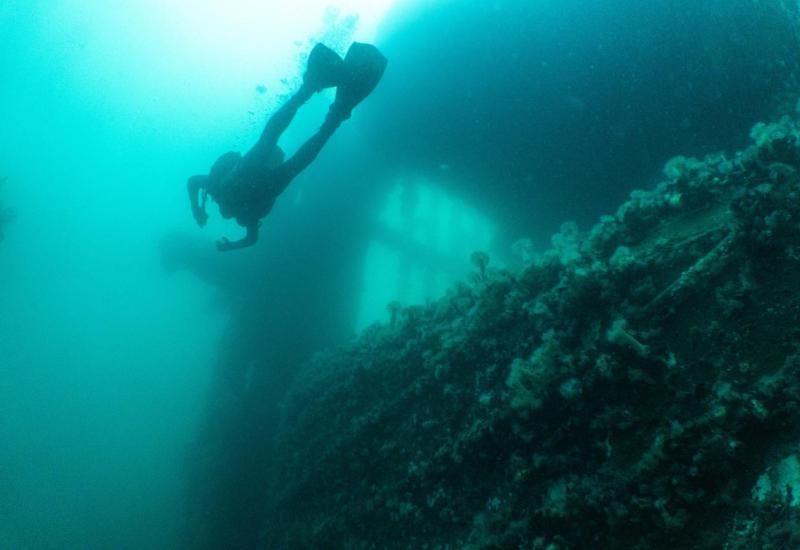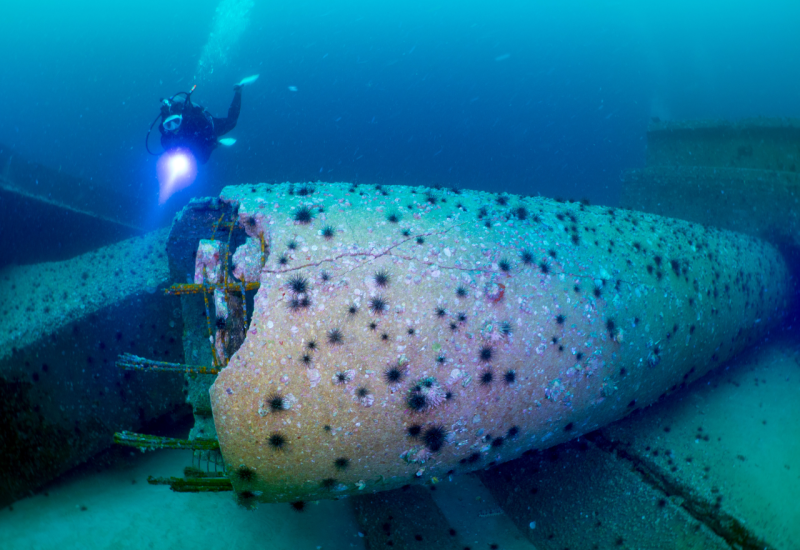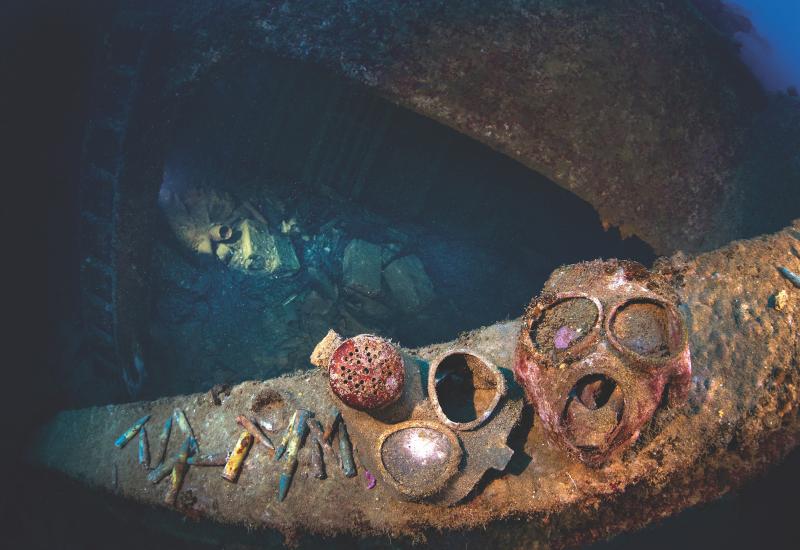What Lies Inside: Exploring Deep Into 6 Epic Wrecks
^^N^^obody likes to be on the outside when it comes to secrets. Wrecks are no different. Only training and experience separate divers limited to exploring the perimeter of a ship, seeing only as much of the interior as they can shine a light on, from those who can venture inside. For those driven to know more and see more, the answer is certification. The right dive education opens the door to these magnificent rooms, where the remnants of each ship’s former life reveal the whole, unedited story.

Mike GerkenWhat It Takes: An advanced nitrox, extended range or equivalent certification.
Nippo Maru [Engine Room]
Truk Lagoon, Micronesia
“Eerie and beautiful.” That’s how Mike Gerken, captain of the Truk-based M/V Odyssey, describes the engine room of the Nippo Maru, a 354-foot Japanese Imperial navy transport ship bombed during Operation Hailstone in 1944 to a depth between 60 and 180 feet.
“The winding staircases and rust-covered ladders and metal platforms all remind me of an M.C. Escher print,” the diving instructor says.
The room, with its shovels and piles of coal still sitting ready on the floor, is immediately recognizable as the engine room, in large part thanks to the ambient light pouring in from skylights, intact and open.
Yet, as much as there’s order to the ship’s structure, there’s a chaos to the room’s entry point — a blast hole 145 feet down.
Gerken says, “Seeing that blast hole — that violence — always leaves a haunting impression on divers.”

Becky Kagan SchottWhat It Takes: An advanced nitrox, extended range or equivalent certification.
Rio de Janeiro Maru [Engine Room]
Truk Lagoon, Micronesia
This 461-foot passenger liner lies on its starboard side, making the trek to the engine room, through hallways and companionways, quite the experience.
“Everything is disjointed — everything is on its side, but you’re right side up, which makes everything more exciting, more confusing and more filled with adrenaline,” Gerken says.
Inside the room, it’s the control panel — with a clock, inclinometer and telegraphs — that steals the most attention. Nearby, the size of the switch panels, generators and pipes often comes as a surprise to most visitors.
Gerken adds, “Wreck diving is all about the bigger the better, and few do it bigger and better than the Rio de Janeiro.”

Alex MustardWhat It Takes: An advanced open water or equivalent certification because the hold isn’t fully an overhead environment. Mustard says, “I strongly recommend people go with a guide, even if they’re experienced, because they’ll see so much more.”
SS Thistlegorm [Hold 2]
Red Sea, Egypt
“It’s not so often you get to see so many World War II vehicles in one place — and Hold 2 is the epicenter of this wreck that’s really a museum of [such] vehicles,” says underwater photographer Alex Mustard, who has logged an estimated 100 dives on the 419-foot British Merchant navy ship.
In the lower level of Hold 2, divers will find 24 trucks and 26 clearly visible Norton motorbikes, as well as airplane wings, engine covers, spare parts and more.
Moreover, the Thistlegorm displays what is perhaps one of the rarest collections of vehicles.
“In the U.K., the different manufacturing companies were asked to convert what they were making into war vehicles, so as a result, you have not one or two types of trucks, but hundreds,” Mustard says. “And a lot of these vehicles, loaded onto the ship in 1940, were obsolete by the end of the war.”
When he couldn’t find any info on the six Crossley trucks he’d photographed in Hold 2, he had to research the answers, learning that this type of truck can be found only on the Thistlegorm and nowhere else in the world.
“Even with all the divers regularly on this ship, there are still so many things to be discovered.”

Becky Kagan SchottWhat It Takes: In addition to cold-water-diving experience, it’s recommended to be certified in normoxic trimix, at a minimum.
SS Daniel J. Morrell [Engine Room]
Lake Huron, Michigan
Most divers who lay eyes on the engine room of this former Great Lakes freighter — now broken in two at a depth of 220 feet in the Thumb Area Great Lakes State Bottomland Preserve — describe it as utterly pristine.
“It’s like somebody turned off the lights 50 years ago and left it in place,” underwater photographer Becky Kagan Schott says. A telegraph, gauge panel, and tools on a bench all appear in working condition — only a lone shoe hints at the ship’s fateful past; 28 of the 29 passengers were lost as the ship sank in 1966.
Today, the ship is quiet. Evidence of the daily duties still hangs in many corners, including a collection of glass jars, each holding nails, screws and other hardware, screwed into the ceiling above the tool bench.
Outside, the wreck’s exterior is covered in quagga mussels, proof of life in Lake Huron. But the inside — free of sunlight and a nutrient-filled water flow — is entirely unclaimed by the invasive species.
It’s clean and well-preserved thanks to the deep, cold fresh water.
Kagan Schott says, “You can still read the words ‘peanut butter’ on the jars.”
USS Oriskany [Hangar Bays]
Panama City, Florida
“The hangar bays are where all the action happened,” says technical diving instructor John Flanders of the ship that Sen. John McCain served on. This space is massive. Find the bays just below the flight deck at 145 feet. Inside, divers can see where the planes were tied down.
It’s one room that’s less about penetration than it is about depth. Says Captain Doug Hammock of H20 Below charters, which takes tec divers to the site, “The bays are wide open — keep in mind that the elevators are big enough for a jet to come through.”
What It Takes: A certification, such as PADI Tec 50 or greater, that allows you to dive to 180 feet.
USNS General Hoyt S. Vandenberg [Engine Room]
Key West, Florida
“The engine room was the beating heart of the Vandy — you get a sense of the massive size and weight of the ship when you’re in that room,” says Joe Weatherby, senior project manager for Artificial Reefs International and project leader for sinking the 524-foot missile-tracking ship.
Inside the engine room — which is six stories high and 100-plus-feet long — Weatherby says, “there’s light, but only enough to make the hair on the back of your neck stand up.”
What It Takes: Advanced nitrox or the equivalent, plus an intro to cave or wreck diving certification.











